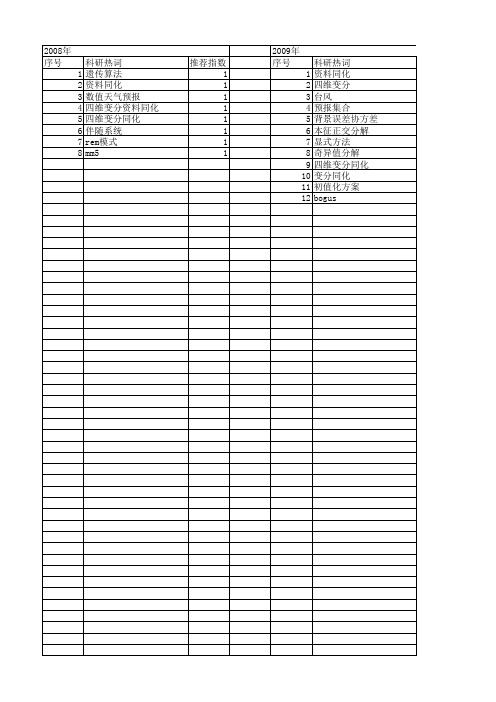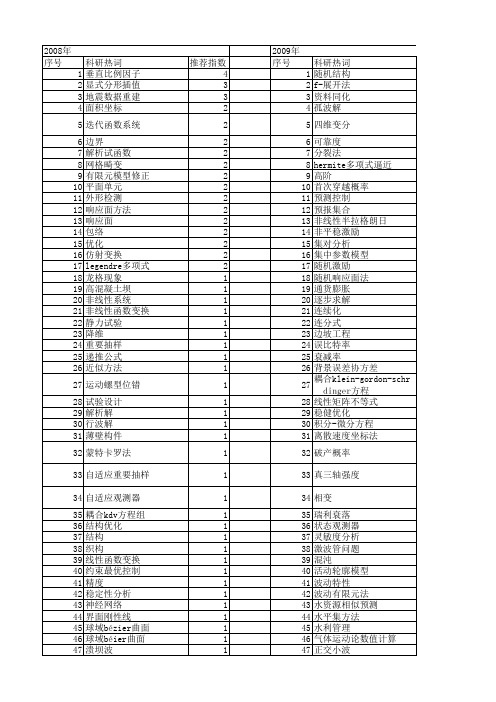基于本征正交分解的显式四维变分同化方法 理论与验证
- 格式:pdf
- 大小:608.17 KB
- 文档页数:8

doi:10.11676/qxxb2024.20230076气象学报CMA-MESO千米尺度变分同化系统中极小化控制变量的重构*王瑞春 龚建东 孙 健WANG Ruichun GONG Jiandong SUN Jian1. 中国气象局地球系统数值预报中心,北京,1000812. 中国气象局地球系统数值预报重点开放实验室,北京,1000813. 中国气象科学研究院灾害天气国家重点实验室,北京,1000811. CMA Earth System Modeling and Prediction Centre,Beijing 100081,China2. CMA Key Laboratory of Earth System Modeling and Prediction,Beijing 100081,China3. State Key Laboratory of Severe Weather,Chinese Academy of Meteorological Sciences,Beijing 100081,China2023-05-22收稿,2023-11-27改回.王瑞春,龚建东,孙健. 2024. CMA-MESO千米尺度变分同化系统中极小化控制变量的重构. 气象学报,82(2):208-221Wang Ruichun, Gong Jiandong, Sun Jian. 2024. A reformulation of the minimization control variables in the CMA-MESO km-scale variational assimilation system. Acta Meteorologica Sinica, 82(2):208-221Abstract In order to improve the analysis capability of micro- and meso-scale flows and provide a kilometer-scale applicable assimilation scheme for the China Meteorological Administration (CMA) operational regional numerical weather prediction system CMA-MESO, a new formulation of the minimization control variables in the GRAPES (Global/Regional Assimilation and Prediction System) variational assimilation system has been developed. The new scheme uses eastward velocity u and northward velocity v to replace the original stream function and velocity potential as the new momentum control variables, and uses temperature and surface pressure (T, p s) to replace the original unbalanced dimensionless pressure as the new mass field control variable. In addition, the new scheme no longer introduces quasi-geostrophic balance constraint but uses a weak mass continuity constraint to ensure analysis balance. Results of background error statistics and numerical experiments show that the adoption of the reformulated control variables results in a more local propagation of observational information and a more reasonable analysis, avoiding the spurious correlation problem of the original scheme when applied at micro- and meso-scale analysis. The introduction of the weak mass continuity constraint suppresses unrealistic convergence and divergence in the analysis, making the new analysis more balanced. Results of one-month assimilation cycles and forecasts show that the new scheme can reduce analysis errors in wind and mass fields, which in turn significantly improves precipitation and 10 m wind field forecast scores of the CMA-MESO system.Key words CMA-MESO, Kilometer scale variational assimilation, Control variables, Balance constraint摘 要 重构GRAPES(Global/Regional Assimilation and Prediction System)全球、区域一体化变分同化系统中的极小化控制变量,提升中、小尺度同化分析能力,为中国气象局业务区域数值预报系统CMA-MESO提供千米尺度适用的同化方案。

集合四维变分资料同化研究进展刘柏年;皇群博;张卫民;曹小群;赵军;赵延来【摘要】Accurate background error covariance is the foundation for all advanced data assimilation systems. For four dimensions data assimilation (4D-Var), assimilating the observation data is converted to a question of cost function minimization which is constricted by atmosphere dynamic model. By adjusting the control vectors, the distance between model trajectory and real time observations reached its minimal value over whole assimilation time window. As background error covariance evolves according to the adjoint and tangent linear model, it can adapt to rapid development weather. However, most of operational 4D-Var systems still adopt simi-climatic background error covariance model compromised by huge dimensionality, which can’t be exactly deifned with all available information. As the rapid development of computer science, the problem of dimensionality can be released by ensemble method. Ensemble four dimensionality data assimilation (En4DVar) employed several independent perturbed analysis forecast cycles to remedy the limited information synchronously. In this scheme, lfow-dependent background error covariance can be estimated from the differences between ensemble members. Several famous numeric prediction centers, such as ECMWF, Mete-France, adopted it to provide lfow-depended background error covariance for the high-resolution determined 4D-Var system. In this thesis, the basic theory of the En4DVar method is demonstrated brielfy, followedby a description of currently application at ECMWF, and focusing on the disturbing, filtering, calibration as well as other key techniques for helping to improve the precision of estimates. The last part presents an investigation of some issues in current operation and possibly future research ifelds in the En4DVar.%背景误差协方差矩阵的精确定义是构建高水平资料同化系统的先决条件。


条件植被温度指数的四维变分与集合卡尔曼同化方法王维;刘翔舸;王鹏新;刘春红【期刊名称】《农业工程学报》【年(卷),期】2011(27)12【摘要】为了提高基于VTCI的干旱监测的准确性,以关中平原为研究区域,将遥感反演的条件植被温度指数(VTCI)与CERES-Wheat小麦生长模犁模拟的土壤浅层水分数据相结合,通过四维变分(4DVAR)与集合卡尔曼滤波(EnKF)2种数据同化算法实现了VTCI的同化.由作物生长模型模拟的土壤浅层水分与VTCI建立经验关系得到模拟的VTCI,再将遥感反演的VTCI与模型模拟值分别应用两种同化算法得到VTCI的单点同化结果,继而应用到区域尺度.结果表明,在VTCI单点实验中,两种同化结果均能结合观测值与模拟值的优点而更加符合VTCI先验知识.在两者区域尺度的同化实验中,由于引入了模型的模拟值,同化后的VTCI区域间纹理更好,减少了原观测图像中相邻像元值陡升陡降的情况,提高了基于VTCI的干旱监测的准确性.通过对比2种同化算法在区域尺度上的同化结果与观测值的差值的概率分布及其均方根误差,表明在以旬为步长的VTCI同化实验中,EnKF方法适用性更强.%The objective of this study was to combine the remotely sensed Vegetation Temperature Condition Index (VTCI) and CERES-Wheat model to get high accuracy of drought monitoring results by using two data assimilation approaches, the Four-dimensional Variational (4DVAR) and Ensemble Kalman Filter (EnKF). VTCI was retrieved from remote sensing data (AVHRR) for drought monitoring, and the surface soil moisture was simulated from the CERES-Wheat model using ground survey data and meteorologicaldata in Guanzhong Plain of Shaanxi province. The simulated VTCI values in the study area were achieved by employing the established empirical linear model between retrieved VTCI and soil surface moisture. The assimilation was carried out in the eight sampling sites and the whole study area, respectively. After establishing the assimilation system, the retrieved VTCI values and the simulated ones of the eight sampling sites were used to test the two assimilation approaches. The results showed that the assimilated VTCI values of the sites were more accurate and closer to the real ones. The texture of the assimilated VTCI image of the whole study area was more smooth than that of the retrieved one, and the sudden changes between the adjacent pixels in the assimilated image were reduced compared to those of the retrieved VTCI image. Based on the prior knowledge of the spatial drought occurrence in the study area, the assimilated VTCI values could get a high accuracy of drought monitoring results. After comparing the distributions of the differences and root mean square errors between the two assimilated VTCI values and the retrieved ones in the study area, it can be concluded that the EnKF approach has stronger applicability and higher accuracy than those of the 4DVAR approach.【总页数】7页(P184-190)【作者】王维;刘翔舸;王鹏新;刘春红【作者单位】中国农业大学信息与电气工程学院,北京100083;中国农业大学信息与电气工程学院,北京100083;中国农业大学信息与电气工程学院,北京100083;中国农业大学信息与电气工程学院,北京100083【正文语种】中文【中图分类】TP79【相关文献】1.应用粒子滤波同化条件植被温度指数的土壤水分估测 [J], 解毅;王鹏新;李俐;荀兰;张树誉2.基于同化叶面积指数和条件植被温度指数的冬小麦单产估测 [J], 张树誉;孙辉涛;王鹏新;景毅刚;李俐3.非线性集合四维变分同化方法NLS-4DVar之局地化改进 [J], 张洪芹;田向军;张承明4.基于四维变分和集合卡尔曼滤波同化方法的冬小麦单产估测 [J], 解毅;王鹏新;刘峻明;李俐5.四维集合变分同化方法在华南冬季暴雨模拟中的应用 [J], 杨雨轩;张立凤;张斌;张明阳;谢宾鹏因版权原因,仅展示原文概要,查看原文内容请购买。

一种显式四维变分资料同化方法
显式四维变分资料同化方法是一种用于将模型输出与观测数据进行比较的技术。
它可以帮助我们更好地了解模型的表现,并提高预测的准确性。
该方法的基本思想是将模型输出与观测数据进行比较,并通过调整模型参数来最小化模型输出与观测数据之间的差异。
这种方法可以用于各种类型的模型,包括气象模型、海洋模型和地球物理模型等。
在四维变分资料同化方法中,我们将模型输出与观测数据进行比较,并计算它们之间的差异。
然后,我们使用变分方法来调整模型参数,以最小化这些差异。
这种方法可以在不增加计算成本的情况下提高预测的准确性。
总的来说,显式四维变分资料同化方法是一种非常有用的技术,可以帮助我们更好地了解模型的表现,并提高预测的准确性。

一种显式四维变分资料同化方法摘要:本文提出了一种显式四维变分资料同化方法,该方法基于四维变分观测算法,利用观测数据和先验知识对待估计的状态进行修正,从而实现对大气环境的精确预测和预报。
该方法在理论和实践中都得到了广泛应用和验证,具有较高的可靠性和实用性。
关键词:四维变分;资料同化;预报;观测数据;先验知识引言大气环境是人类生存和发展的重要基础,对其精确的预测和预报具有重要意义。
资料同化作为一种有效的大气环境预报方法,已经成为气象学研究的热点和难点之一。
传统的资料同化方法主要基于三维变分观测算法,该方法在处理大气环境复杂动力学过程中存在一定的不足,如对局部不均匀性的处理不够精确等。
因此,开发一种更加精确、高效的资料同化方法,对于提升大气环境预测和预报的能力具有重要意义。
本文提出了一种显式四维变分资料同化方法,该方法基于四维变分观测算法,利用观测数据和先验知识对待估计的状态进行修正,从而实现对大气环境的精确预测和预报。
该方法在理论和实践中都得到了广泛应用和验证,具有较高的可靠性和实用性。
一、四维变分观测算法四维变分观测算法是一种基于贝叶斯方法的资料同化方法,其核心思想是利用观测数据和先验知识对待估计的状态进行修正,从而得到更加精确的状态估计。
该方法将预测和观测过程融合在一起,形成一个四维时空的观测系统,通过对时间和空间的联合优化,实现对大气环境的精确预测和预报。
四维变分观测算法的基本框架如下:(1)状态方程:描述大气环境的演化过程,通常采用数值模型进行描述。
(2)观测方程:描述观测数据与状态之间的关系,通常采用观测模型进行描述。
(3)先验分布:描述状态的先验知识,通常采用统计方法进行描述。
(4)后验分布:描述状态的后验知识,即在观测数据和先验知识的基础上得到的状态估计值。
四维变分观测算法的基本流程如下:(1)初始化:确定状态的先验分布和观测方程。
(2)预测:利用状态方程对状态进行预测。
(3)观测:利用观测方程对状态进行观测。
基于进化方向遗传算法的四维变分资料同化方法
王顺凤;沈桐立;张建伟;孙麟平
【期刊名称】《大气科学学报》
【年(卷),期】2002(025)006
【摘要】数值天气预报模式初始时刻要素场的变分同化问题是一个非线性最优化问题.利用进化方向遗传算法(EDGA)求解该最优化问题,并对理想初始场作数值模拟,结果表明模拟效果较好.
【总页数】7页(P740-746)
【作者】王顺凤;沈桐立;张建伟;孙麟平
【作者单位】南京气象学院,数学系,江苏,南京,210044;南京气象学院,大气科学系,江苏,南京,210044;南京气象学院,数学系,江苏,南京,210044;南京大学,数学系,江苏,南京,210008
【正文语种】中文
【中图分类】P435.1
【相关文献】
1.基于遗传算法的四维变分资料同化技术的研究 [J], 胡娅敏;丁一汇;沈桐立
2.基于历史预报的四维变分资料同化(4DVar)方法中的滤波 [J], 刘娟娟
3.四维变分资料同化中非平衡项方差的流依赖估计 [J], 侯士成;刘柏年;曹小群
4.基于扰动模式的四维变分资料同化系统框架的设计完善和数值试验 [J], 冯业荣;薛纪善;李梦婕;戴光丰
5.雷达资料快速更新四维变分同化中增加地面资料同化对强对流临近数值预报的影响 [J], 刘瑞婷;陈明轩;肖现;秦睿;高峰;杨璐;吴剑坤;孙娟珍
因版权原因,仅展示原文概要,查看原文内容请购买。